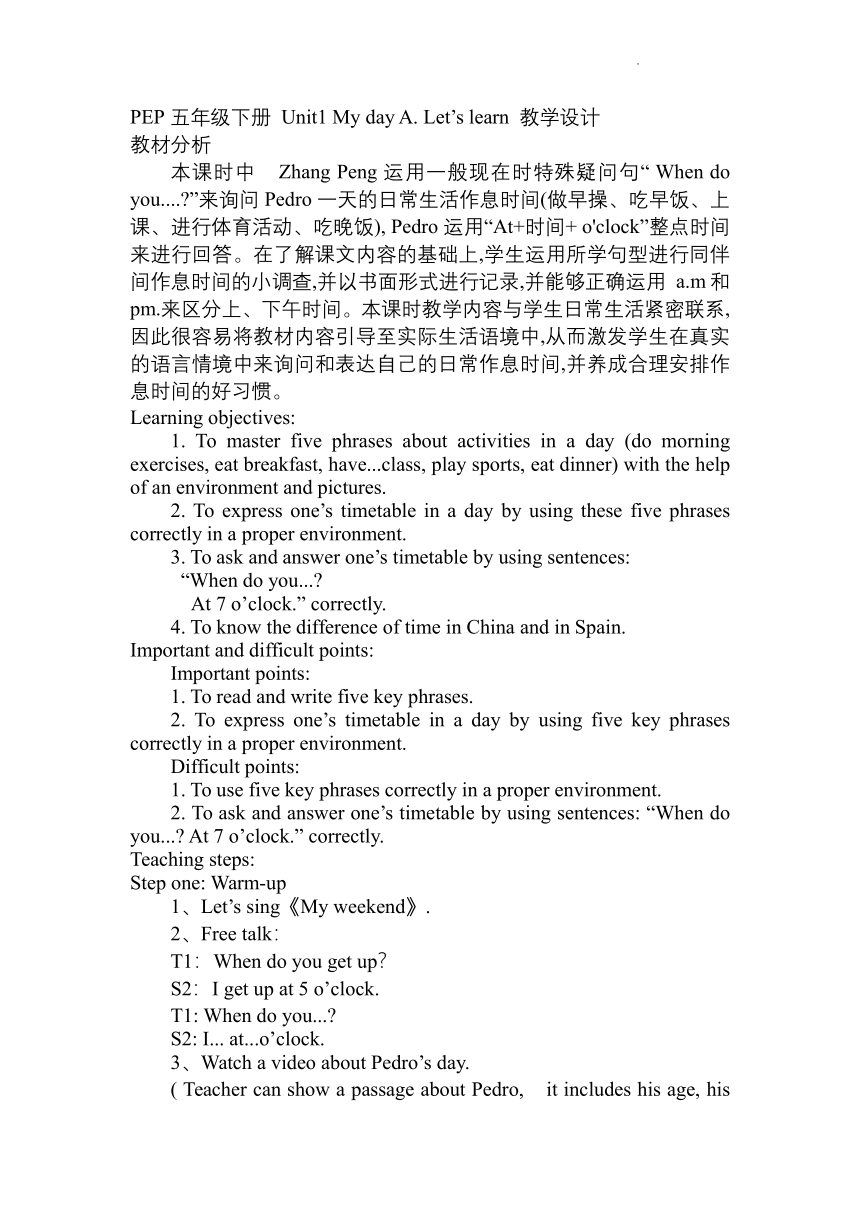Unit1 My day Part A. Let’s learn教案(含教学反思)
文档属性
| 名称 | Unit1 My day Part A. Let’s learn教案(含教学反思) |  | |
| 格式 | zip | ||
| 文件大小 | 82.9KB | ||
| 资源类型 | 教案 | ||
| 版本资源 | 人教版(PEP) | ||
| 科目 | 英语 | ||
| 更新时间 | 2022-05-01 23:30:23 | ||
图片预览

文档简介
PEP五年级下册 Unit1 My day A. Let’s learn 教学设计
教材分析
本课时中 Zhang Peng运用一般现在时特殊疑问句“ When do you.... ”来询问Pedro一天的日常生活作息时间(做早操、吃早饭、上课、进行体育活动、吃晚饭), Pedro运用“At+时间+ o'clock”整点时间来进行回答。在了解课文内容的基础上,学生运用所学句型进行同伴间作息时间的小调查,并以书面形式进行记录,并能够正确运用 a.m和 pm.来区分上、下午时间。本课时教学内容与学生日常生活紧密联系,因此很容易将教材内容引导至实际生活语境中,从而激发学生在真实的语言情境中来询问和表达自己的日常作息时间,并养成合理安排作息时间的好习惯。
Learning objectives:
1. To master five phrases about activities in a day (do morning exercises, eat breakfast, have...class, play sports, eat dinner) with the help of an environment and pictures.
2. To express one’s timetable in a day by using these five phrases correctly in a proper environment.
3. To ask and answer one’s timetable by using sentences:
“When do you...
At 7 o’clock.” correctly.
4. To know the difference of time in China and in Spain.
Important and difficult points:
Important points:
1. To read and write five key phrases.
2. To express one’s timetable in a day by using five key phrases correctly in a proper environment.
Difficult points:
1. To use five key phrases correctly in a proper environment.
2. To ask and answer one’s timetable by using sentences: “When do you... At 7 o’clock.” correctly.
Teaching steps:
Step one: Warm-up
1、Let’s sing《My weekend》.
2、Free talk:
T1:When do you get up?
S2:I get up at 5 o’clock.
T1: When do you...
S2: I... at...o’clock.
3、Watch a video about Pedro’s day.
( Teacher can show a passage about Pedro, it includes his age, his nationality, his activities and time. Students can get some information from the introduction. )
Teacher can show the topic of this class. “ Pedro’s day”. Then, match Pedro’s activity and time.
Step two: Presentation
1. T: What does Pedro do in a day
Show students pictures of “let’s learn” in the way of comic strip.
(show a picture without a phrase)
Students look at pictures and try to guess.
2. To learn new phrases after seeing these pictures.
(students could try to read some new phrases.)
Teacher can invite some students to read new phrases he can.
Emphasize some words’ pronunciation:
“exercises, breakfast”. Pay attention to saying the sentences “ At 7 o’clock, I ....” or “I ... at 7 o’clock.”
Step three: Practice
1. Students read these new phrases by themselves or in a group for three minutes. Then, show activities and students say the proper phrase correctly.
2. Look at pictures and try to write the phrases.3. To introduce Pedro’s day in pairs.
Step Four: Production
1. Show Zhang Peng’s day and know the difference of time in China and in Spain.
2. To finish “ Ask and write”
( ask about partner’s timetable.)
e.g.
A: When do you get up
B: I get up at... .....
Step Five: Progress根据首字母提示书写合适的短语.
1.We usually (e)_________________ at 6:30 p.m. in China.
2.My grandpa likes to (d)________________ in the morning every day.
3.Let’s go to the playground and (h)__________________.
4.We must (p)______________and keep healthy.
Summary .
Design
Unit1 My day A. Let’s learn
课后反思
本课时为学生创设了一个生动活泼的语言学习环境,主要是对于一般现在时特殊疑问句“ When do you... ”“At...”句型的理解和运用。本节课教学内容是在上一课时的基础上对“ When do you... ”句型的拓展运用,教学内容是谈论学生的日常生活作息时间,相对比较简单。因此学生能够轻松掌握单词和句型,并能运用单词和句型进行简单的拓展练习活动。通过展示图片让学生猜测相应的作息时间,来激发学生用英语解决问题的能力,提高了学生学习的兴趣。最后通过作息时间小调查来促使学生在活动中互相学习,互相帮助,鼓励学生大胆地使用英语,并逐步提高学生的综合运用语言的能力。
教材分析
本课时中 Zhang Peng运用一般现在时特殊疑问句“ When do you.... ”来询问Pedro一天的日常生活作息时间(做早操、吃早饭、上课、进行体育活动、吃晚饭), Pedro运用“At+时间+ o'clock”整点时间来进行回答。在了解课文内容的基础上,学生运用所学句型进行同伴间作息时间的小调查,并以书面形式进行记录,并能够正确运用 a.m和 pm.来区分上、下午时间。本课时教学内容与学生日常生活紧密联系,因此很容易将教材内容引导至实际生活语境中,从而激发学生在真实的语言情境中来询问和表达自己的日常作息时间,并养成合理安排作息时间的好习惯。
Learning objectives:
1. To master five phrases about activities in a day (do morning exercises, eat breakfast, have...class, play sports, eat dinner) with the help of an environment and pictures.
2. To express one’s timetable in a day by using these five phrases correctly in a proper environment.
3. To ask and answer one’s timetable by using sentences:
“When do you...
At 7 o’clock.” correctly.
4. To know the difference of time in China and in Spain.
Important and difficult points:
Important points:
1. To read and write five key phrases.
2. To express one’s timetable in a day by using five key phrases correctly in a proper environment.
Difficult points:
1. To use five key phrases correctly in a proper environment.
2. To ask and answer one’s timetable by using sentences: “When do you... At 7 o’clock.” correctly.
Teaching steps:
Step one: Warm-up
1、Let’s sing《My weekend》.
2、Free talk:
T1:When do you get up?
S2:I get up at 5 o’clock.
T1: When do you...
S2: I... at...o’clock.
3、Watch a video about Pedro’s day.
( Teacher can show a passage about Pedro, it includes his age, his nationality, his activities and time. Students can get some information from the introduction. )
Teacher can show the topic of this class. “ Pedro’s day”. Then, match Pedro’s activity and time.
Step two: Presentation
1. T: What does Pedro do in a day
Show students pictures of “let’s learn” in the way of comic strip.
(show a picture without a phrase)
Students look at pictures and try to guess.
2. To learn new phrases after seeing these pictures.
(students could try to read some new phrases.)
Teacher can invite some students to read new phrases he can.
Emphasize some words’ pronunciation:
“exercises, breakfast”. Pay attention to saying the sentences “ At 7 o’clock, I ....” or “I ... at 7 o’clock.”
Step three: Practice
1. Students read these new phrases by themselves or in a group for three minutes. Then, show activities and students say the proper phrase correctly.
2. Look at pictures and try to write the phrases.3. To introduce Pedro’s day in pairs.
Step Four: Production
1. Show Zhang Peng’s day and know the difference of time in China and in Spain.
2. To finish “ Ask and write”
( ask about partner’s timetable.)
e.g.
A: When do you get up
B: I get up at... .....
Step Five: Progress根据首字母提示书写合适的短语.
1.We usually (e)_________________ at 6:30 p.m. in China.
2.My grandpa likes to (d)________________ in the morning every day.
3.Let’s go to the playground and (h)__________________.
4.We must (p)______________and keep healthy.
Summary .
Design
Unit1 My day A. Let’s learn
课后反思
本课时为学生创设了一个生动活泼的语言学习环境,主要是对于一般现在时特殊疑问句“ When do you... ”“At...”句型的理解和运用。本节课教学内容是在上一课时的基础上对“ When do you... ”句型的拓展运用,教学内容是谈论学生的日常生活作息时间,相对比较简单。因此学生能够轻松掌握单词和句型,并能运用单词和句型进行简单的拓展练习活动。通过展示图片让学生猜测相应的作息时间,来激发学生用英语解决问题的能力,提高了学生学习的兴趣。最后通过作息时间小调查来促使学生在活动中互相学习,互相帮助,鼓励学生大胆地使用英语,并逐步提高学生的综合运用语言的能力。
